seats MAZDA MODEL MAZDASPEED 6 2006 (in English) User Guide
[x] Cancel search | Manufacturer: MAZDA, Model Year: 2006, Model line: MODEL MAZDASPEED 6, Model: MAZDA MODEL MAZDASPEED 6 2006Pages: 354, PDF Size: 6.5 MB
Page 21 of 354
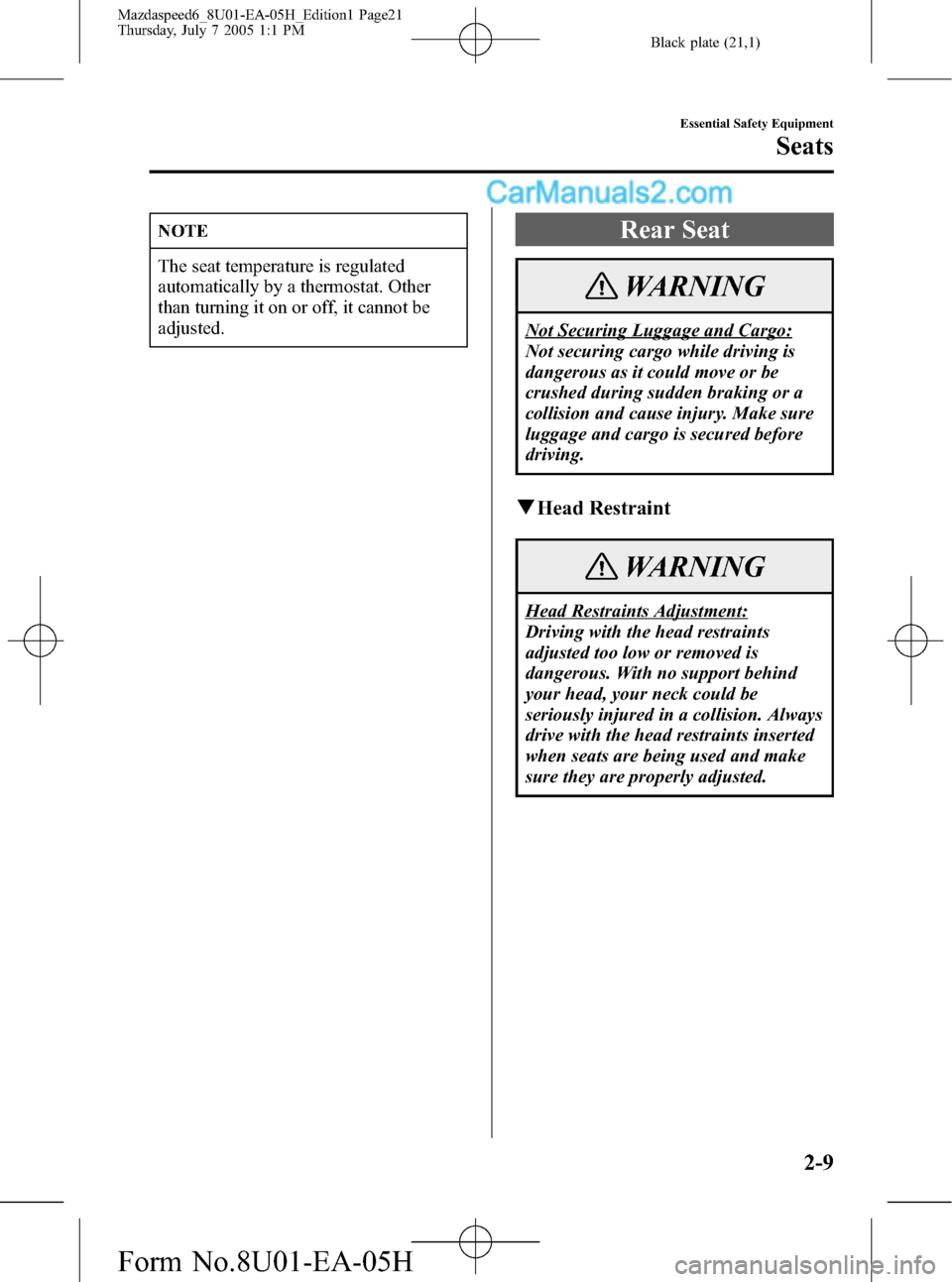
Black plate (21,1)
NOTE
The seat temperature is regulated
automatically by a thermostat. Other
than turning it on or off, it cannot be
adjusted.
Rear Seat
WARNING
Not Securing Luggage and Cargo:
Not securing cargo while driving is
dangerous as it could move or be
crushed during sudden braking or a
collision and cause injury. Make sure
luggage and cargo is secured before
driving.
qHead Restraint
WARNING
Head Restraints Adjustment:
Driving with the head restraints
adjusted too low or removed is
dangerous. With no support behind
your head, your neck could be
seriously injured in a collision. Always
drive with the head restraints inserted
when seats are being used and make
sure they are properly adjusted.
Essential Safety Equipment
Seats
2-9
Mazdaspeed6_8U01-EA-05H_Edition1 Page21
Thursday, July 7 2005 1:1 PM
Form No.8U01-EA-05H
Page 22 of 354
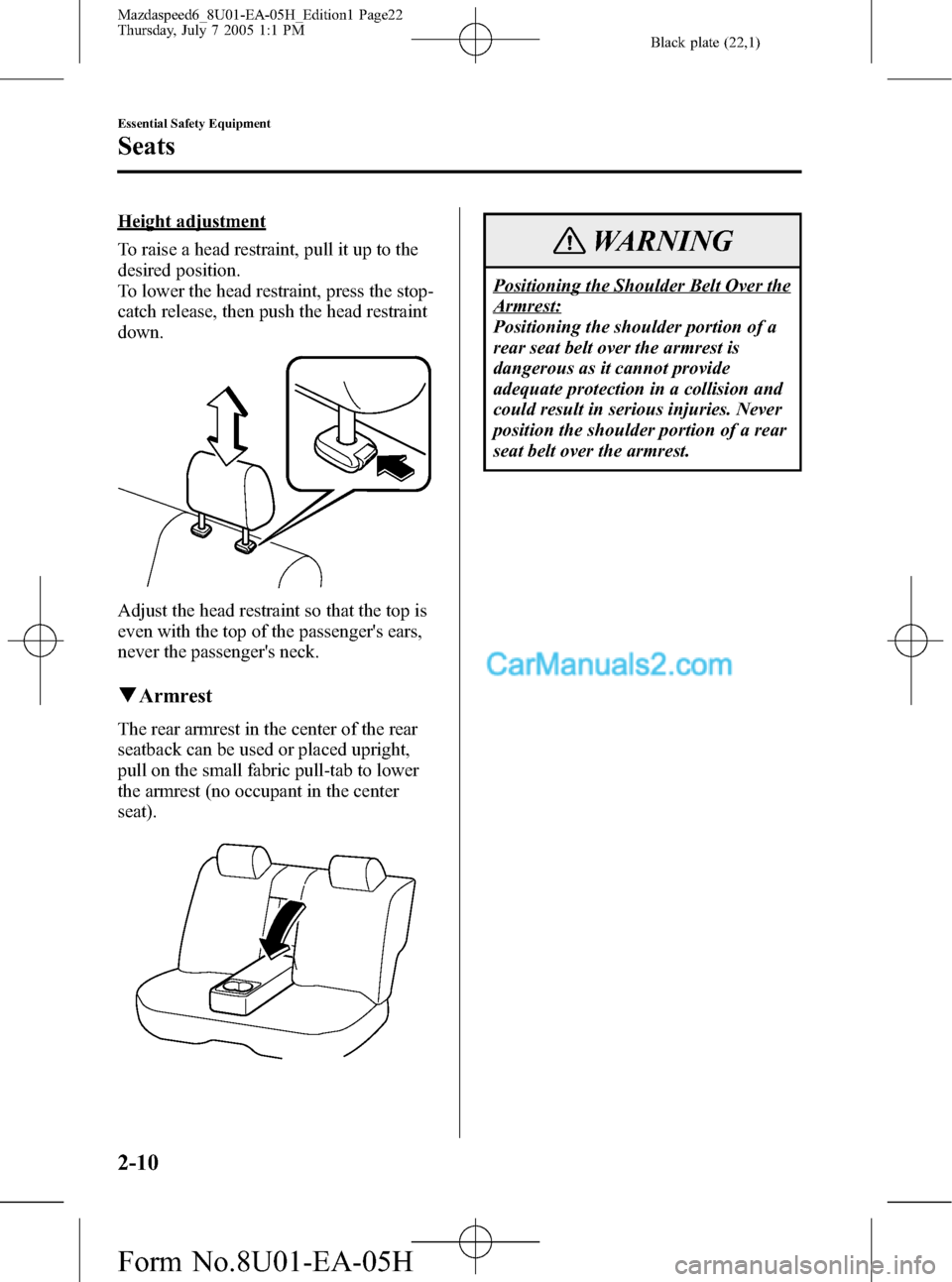
Black plate (22,1)
Height adjustment
To raise a head restraint, pull it up to the
desired position.
To lower the head restraint, press the stop-
catch release, then push the head restraint
down.
Adjust the head restraint so that the top is
even with the top of the passenger's ears,
never the passenger's neck.
qArmrest
The rear armrest in the center of the rear
seatback can be used or placed upright,
pull on the small fabric pull-tab to lower
the armrest (no occupant in the center
seat).
WARNING
Positioning the Shoulder Belt Over the
Armrest:
Positioning the shoulder portion of a
rear seat belt over the armrest is
dangerous as it cannot provide
adequate protection in a collision and
could result in serious injuries. Never
position the shoulder portion of a rear
seat belt over the armrest.
2-10
Essential Safety Equipment
Seats
Mazdaspeed6_8U01-EA-05H_Edition1 Page22
Thursday, July 7 2005 1:1 PM
Form No.8U01-EA-05H
Page 23 of 354
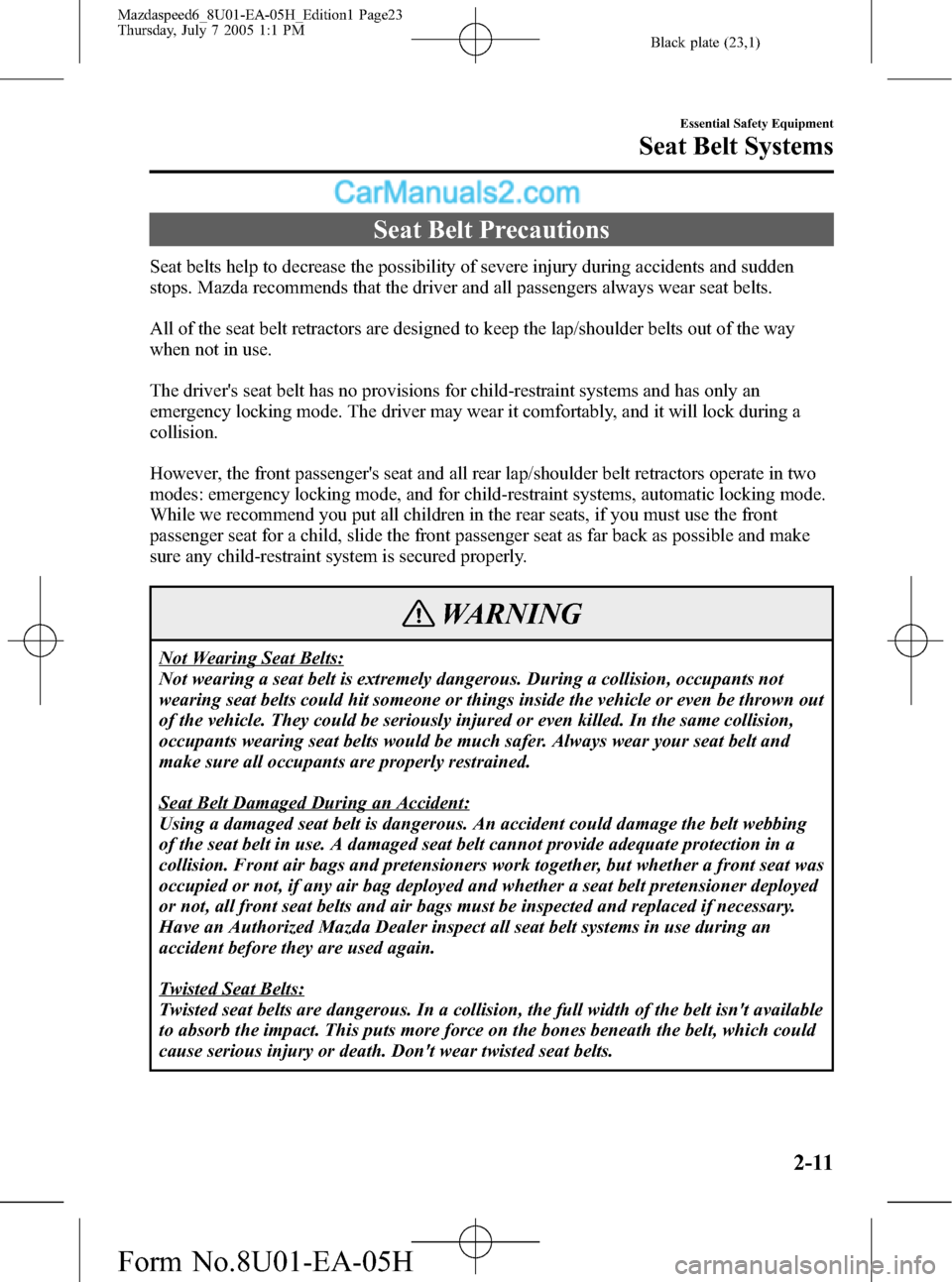
Black plate (23,1)
Seat Belt Precautions
Seat belts help to decrease the possibility of severe injury during accidents and sudden
stops. Mazda recommends that the driver and all passengers always wear seat belts.
All of the seat belt retractors are designed to keep the lap/shoulder belts out of the way
when not in use.
The driver's seat belt has no provisions for child-restraint systems and has only an
emergency locking mode. The driver may wear it comfortably, and it will lock during a
collision.
However, the front passenger's seat and all rear lap/shoulder belt retractors operate in two
modes: emergency locking mode, and for child-restraint systems, automatic locking mode.
While we recommend you put all children in the rear seats, if you must use the front
passenger seat for a child, slide the front passenger seat as far back as possible and make
sure any child-restraint system is secured properly.
WARNING
Not Wearing Seat Belts:
Not wearing a seat belt is extremely dangerous. During a collision, occupants not
wearing seat belts could hit someone or things inside the vehicle or even be thrown out
of the vehicle. They could be seriously injured or even killed. In the same collision,
occupants wearing seat belts would be much safer. Always wear your seat belt and
make sure all occupants are properly restrained.
Seat Belt Damaged During an Accident:
Using a damaged seat belt is dangerous. An accident could damage the belt webbing
of the seat belt in use. A damaged seat belt cannot provide adequate protection in a
collision. Front air bags and pretensioners work together, but whether a front seat was
occupied or not, if any air bag deployed and whether a seat belt pretensioner deployed
or not, all front seat belts and air bags must be inspected and replaced if necessary.
Have an Authorized Mazda Dealer inspect all seat belt systems in use during an
accident before they are used again.
Twisted Seat Belts:
Twisted seat belts are dangerous. In a collision, the full width of the belt isn't available
to absorb the impact. This puts more force on the bones beneath the belt, which could
cause serious injury or death. Don't wear twisted seat belts.
Essential Safety Equipment
Seat Belt Systems
2-11
Mazdaspeed6_8U01-EA-05H_Edition1 Page23
Thursday, July 7 2005 1:1 PM
Form No.8U01-EA-05H
Page 35 of 354
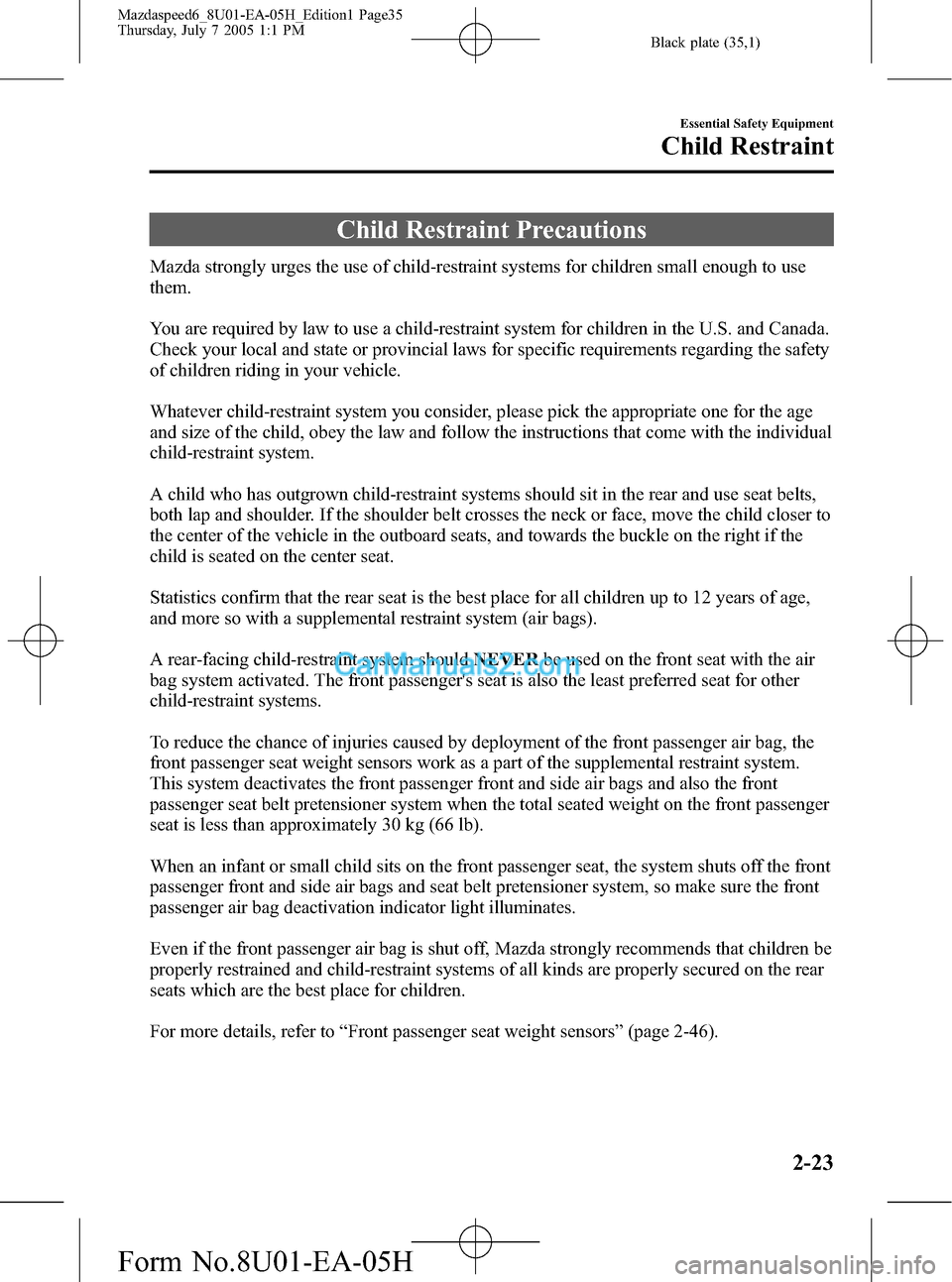
Black plate (35,1)
Child Restraint Precautions
Mazda strongly urges the use of child-restraint systems for children small enough to use
them.
You are required by law to use a child-restraint system for children in the U.S. and Canada.
Check your local and state or provincial laws for specific requirements regarding the safety
of children riding in your vehicle.
Whatever child-restraint system you consider, please pick the appropriate one for the age
and size of the child, obey the law and follow the instructions that come with the individual
child-restraint system.
A child who has outgrown child-restraint systems should sit in the rear and use seat belts,
both lap and shoulder. If the shoulder belt crosses the neck or face, move the child closer to
the center of the vehicle in the outboard seats, and towards the buckle on the right if the
child is seated on the center seat.
Statistics confirm that the rear seat is the best place for all children up to 12 years of age,
and more so with a supplemental restraint system (air bags).
A rear-facing child-restraint system shouldNEVERbe used on the front seat with the air
bag system activated. The front passenger's seat is also the least preferred seat for other
child-restraint systems.
To reduce the chance of injuries caused by deployment of the front passenger air bag, the
front passenger seat weight sensors work as a part of the supplemental restraint system.
This system deactivates the front passenger front and side air bags and also the front
passenger seat belt pretensioner system when the total seated weight on the front passenger
seat is less than approximately 30 kg (66 lb).
When an infant or small child sits on the front passenger seat, the system shuts off the front
passenger front and side air bags and seat belt pretensioner system, so make sure the front
passenger air bag deactivation indicator light illuminates.
Even if the front passenger air bag is shut off, Mazda strongly recommends that children be
properly restrained and child-restraint systems of all kinds are properly secured on the rear
seats which are the best place for children.
For more details, refer to“Front passenger seat weight sensors”(page 2-46).
Essential Safety Equipment
Child Restraint
2-23
Mazdaspeed6_8U01-EA-05H_Edition1 Page35
Thursday, July 7 2005 1:1 PM
Form No.8U01-EA-05H
Page 37 of 354
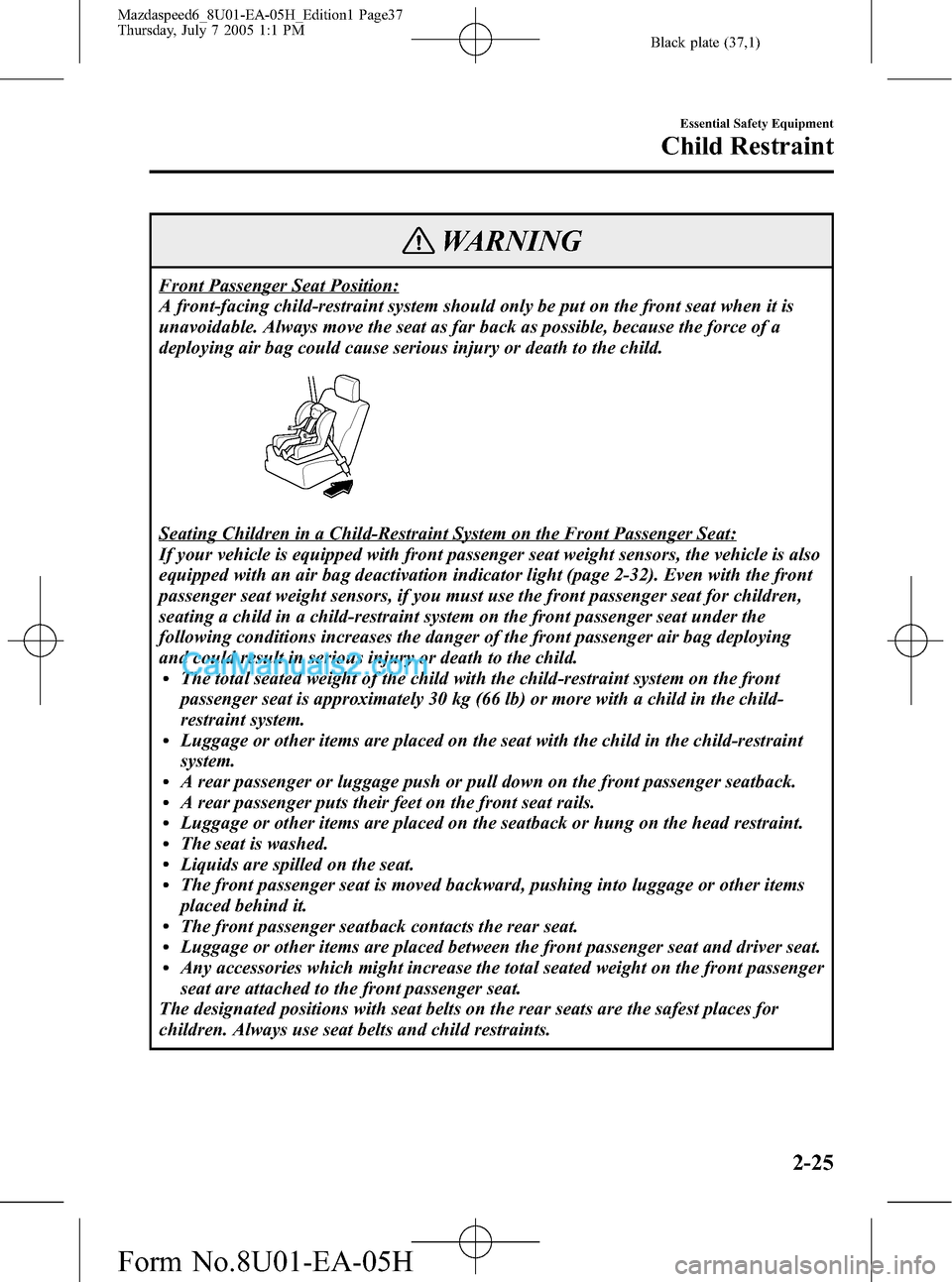
Black plate (37,1)
WARNING
Front Passenger Seat Position:
A front-facing child-restraint system should only be put on the front seat when it is
unavoidable. Always move the seat as far back as possible, because the force of a
deploying air bag could cause serious injury or death to the child.
Seating Children in a Child-Restraint System on the Front Passenger Seat:
If your vehicle is equipped with front passenger seat weight sensors, the vehicle is also
equipped with an air bag deactivation indicator light (page 2-32). Even with the front
passenger seat weight sensors, if you must use the front passenger seat for children,
seating a child in a child-restraint system on the front passenger seat under the
following conditions increases the danger of the front passenger air bag deploying
and could result in serious injury or death to the child.
lThe total seated weight of the child with the child-restraint system on the front
passenger seat is approximately 30 kg (66 lb) or more with a child in the child-
restraint system.
lLuggage or other items are placed on the seat with the child in the child-restraint
system.
lA rear passenger or luggage push or pull down on the front passenger seatback.lA rear passenger puts their feet on the front seat rails.lLuggage or other items are placed on the seatback or hung on the head restraint.lThe seat is washed.lLiquids are spilled on the seat.lThe front passenger seat is moved backward, pushing into luggage or other items
placed behind it.
lThe front passenger seatback contacts the rear seat.lLuggage or other items are placed between the front passenger seat and driver seat.lAny accessories which might increase the total seated weight on the front passenger
seat are attached to the front passenger seat.
The designated positions with seat belts on the rear seats are the safest places for
children. Always use seat belts and child restraints.
Essential Safety Equipment
Child Restraint
2-25
Mazdaspeed6_8U01-EA-05H_Edition1 Page37
Thursday, July 7 2005 1:1 PM
Form No.8U01-EA-05H
Page 39 of 354
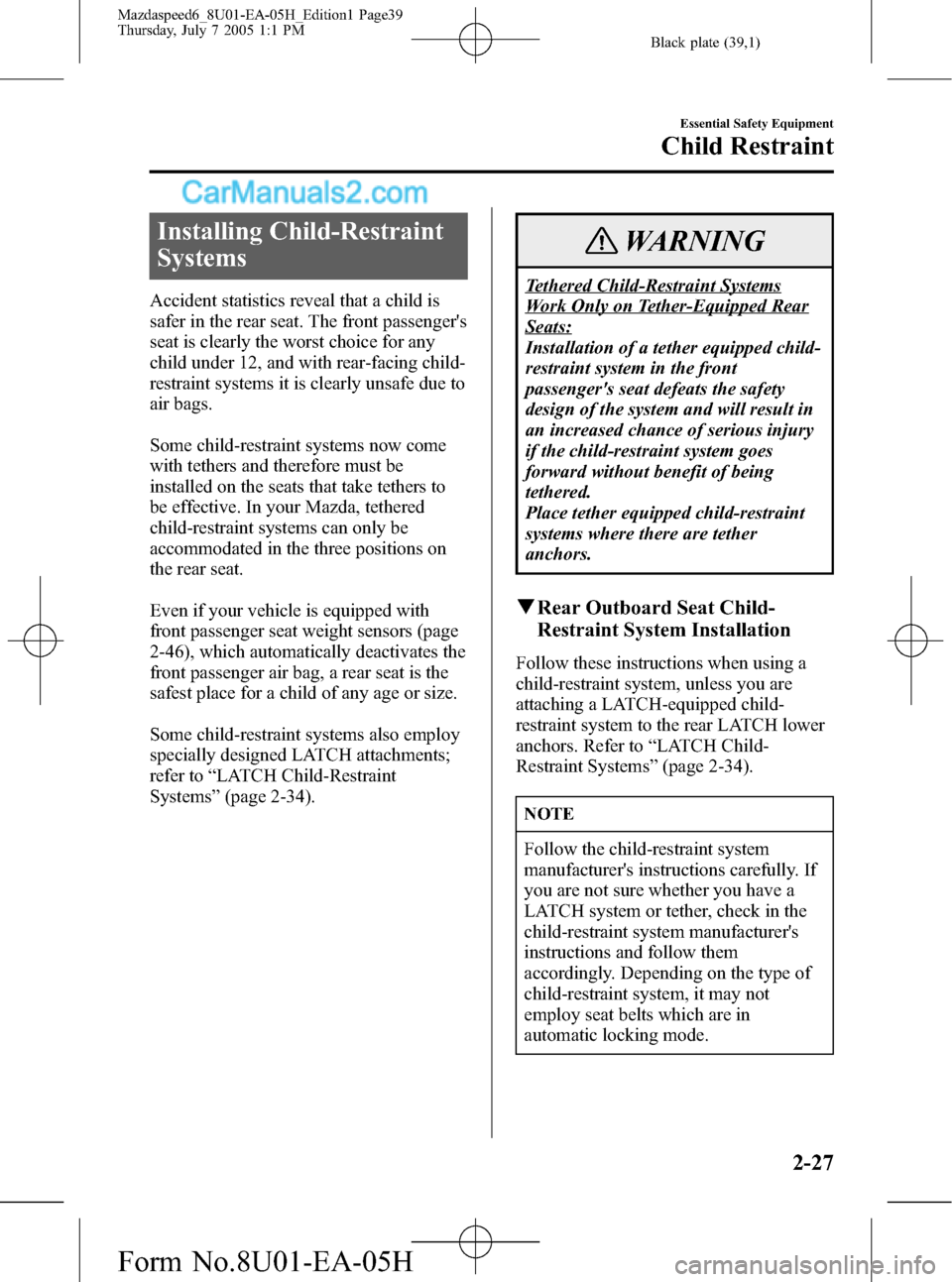
Black plate (39,1)
Installing Child-Restraint
Systems
Accident statistics reveal that a child is
safer in the rear seat. The front passenger's
seat is clearly the worst choice for any
child under 12, and with rear-facing child-
restraint systems it is clearly unsafe due to
air bags.
Some child-restraint systems now come
with tethers and therefore must be
installed on the seats that take tethers to
be effective. In your Mazda, tethered
child-restraint systems can only be
accommodated in the three positions on
the rear seat.
Even if your vehicle is equipped with
front passenger seat weight sensors (page
2-46), which automatically deactivates the
front passenger air bag, a rear seat is the
safest place for a child of any age or size.
Some child-restraint systems also employ
specially designed LATCH attachments;
refer to“LATCH Child-Restraint
Systems”(page 2-34).
WARNING
Tethered Child-Restraint Systems
Work Only on Tether-Equipped Rear
Seats:
Installation of a tether equipped child-
restraint system in the front
passenger's seat defeats the safety
design of the system and will result in
an increased chance of serious injury
if the child-restraint system goes
forward without benefit of being
tethered.
Place tether equipped child-restraint
systems where there are tether
anchors.
qRear Outboard Seat Child-
Restraint System Installation
Follow these instructions when using a
child-restraint system, unless you are
attaching a LATCH-equipped child-
restraint system to the rear LATCH lower
anchors. Refer to“LATCH Child-
Restraint Systems”(page 2-34).
NOTE
Follow the child-restraint system
manufacturer's instructions carefully. If
you are not sure whether you have a
LATCH system or tether, check in the
child-restraint system manufacturer's
instructions and follow them
accordingly. Depending on the type of
child-restraint system, it may not
employ seat belts which are in
automatic locking mode.
Essential Safety Equipment
Child Restraint
2-27
Mazdaspeed6_8U01-EA-05H_Edition1 Page39
Thursday, July 7 2005 1:1 PM
Form No.8U01-EA-05H
Page 42 of 354
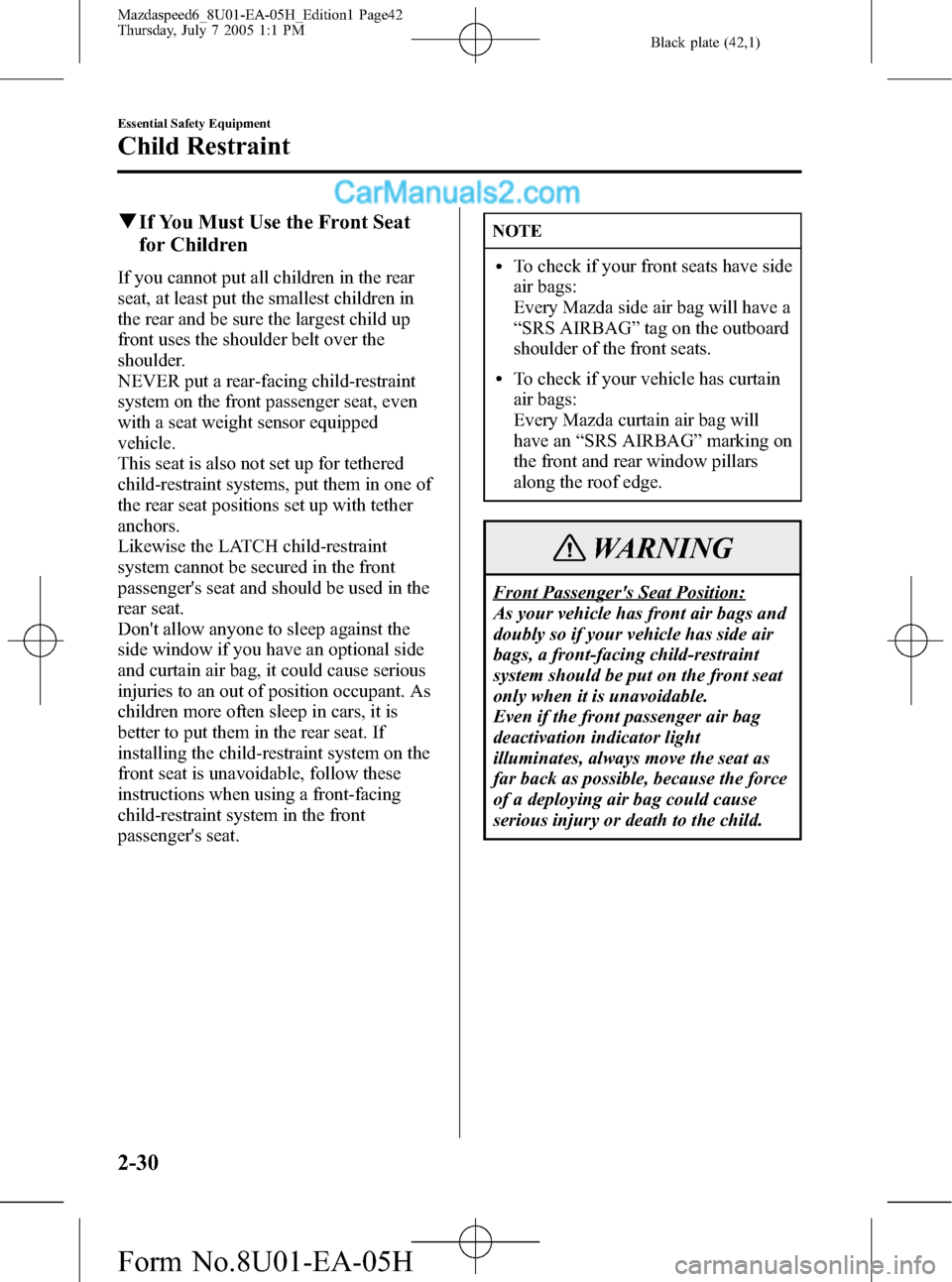
Black plate (42,1)
qIf You Must Use the Front Seat
for Children
If you cannot put all children in the rear
seat, at least put the smallest children in
the rear and be sure the largest child up
front uses the shoulder belt over the
shoulder.
NEVER put a rear-facing child-restraint
system on the front passenger seat, even
with a seat weight sensor equipped
vehicle.
This seat is also not set up for tethered
child-restraint systems, put them in one of
the rear seat positions set up with tether
anchors.
Likewise the LATCH child-restraint
system cannot be secured in the front
passenger's seat and should be used in the
rear seat.
Don't allow anyone to sleep against the
side window if you have an optional side
and curtain air bag, it could cause serious
injuries to an out of position occupant. As
children more often sleep in cars, it is
better to put them in the rear seat. If
installing the child-restraint system on the
front seat is unavoidable, follow these
instructions when using a front-facing
child-restraint system in the front
passenger's seat.
NOTE
lTo check if your front seats have side
air bags:
Every Mazda side air bag will have a
“SRS AIRBAG”tag on the outboard
shoulder of the front seats.
lTo check if your vehicle has curtain
air bags:
Every Mazda curtain air bag will
have an“SRS AIRBAG”marking on
the front and rear window pillars
along the roof edge.
WARNING
Front Passenger's Seat Position:
As your vehicle has front air bags and
doubly so if your vehicle has side air
bags, a front-facing child-restraint
system should be put on the front seat
only when it is unavoidable.
Even if the front passenger air bag
deactivation indicator light
illuminates, always move the seat as
far back as possible, because the force
of a deploying air bag could cause
serious injury or death to the child.
2-30
Essential Safety Equipment
Child Restraint
Mazdaspeed6_8U01-EA-05H_Edition1 Page42
Thursday, July 7 2005 1:1 PM
Form No.8U01-EA-05H
Page 47 of 354

Black plate (47,1)
qLATCH Child-Restraint System
Installation Procedure (Rear
Outboard Seats)
1. Expand the area between the seat
bottom and the seatback slightly to
verify the locations of the LATCH
lower anchors.
NOTE
The markings above the LATCH lower
anchors indicate the locations of
LATCH lower anchors for the
attachment of a child-restraint system.
2. Secure the child-restraint system using
BOTH LATCH lower anchors,
following the child-restraint system
manufacturer's instruction.
3. If your child-restraint system came
equipped with a tether, that probably
means it is very important to properly
secure the tether for child safety, please
carefully follow the child-restraint
system manufacturer's instructions
when installing tethers.Anchor bracket location
Tether strap position
Anchor
bracketTether
strap
Essential Safety Equipment
Child Restraint
2-35
Mazdaspeed6_8U01-EA-05H_Edition1 Page47
Thursday, July 7 2005 1:2 PM
Form No.8U01-EA-05H
Page 50 of 354
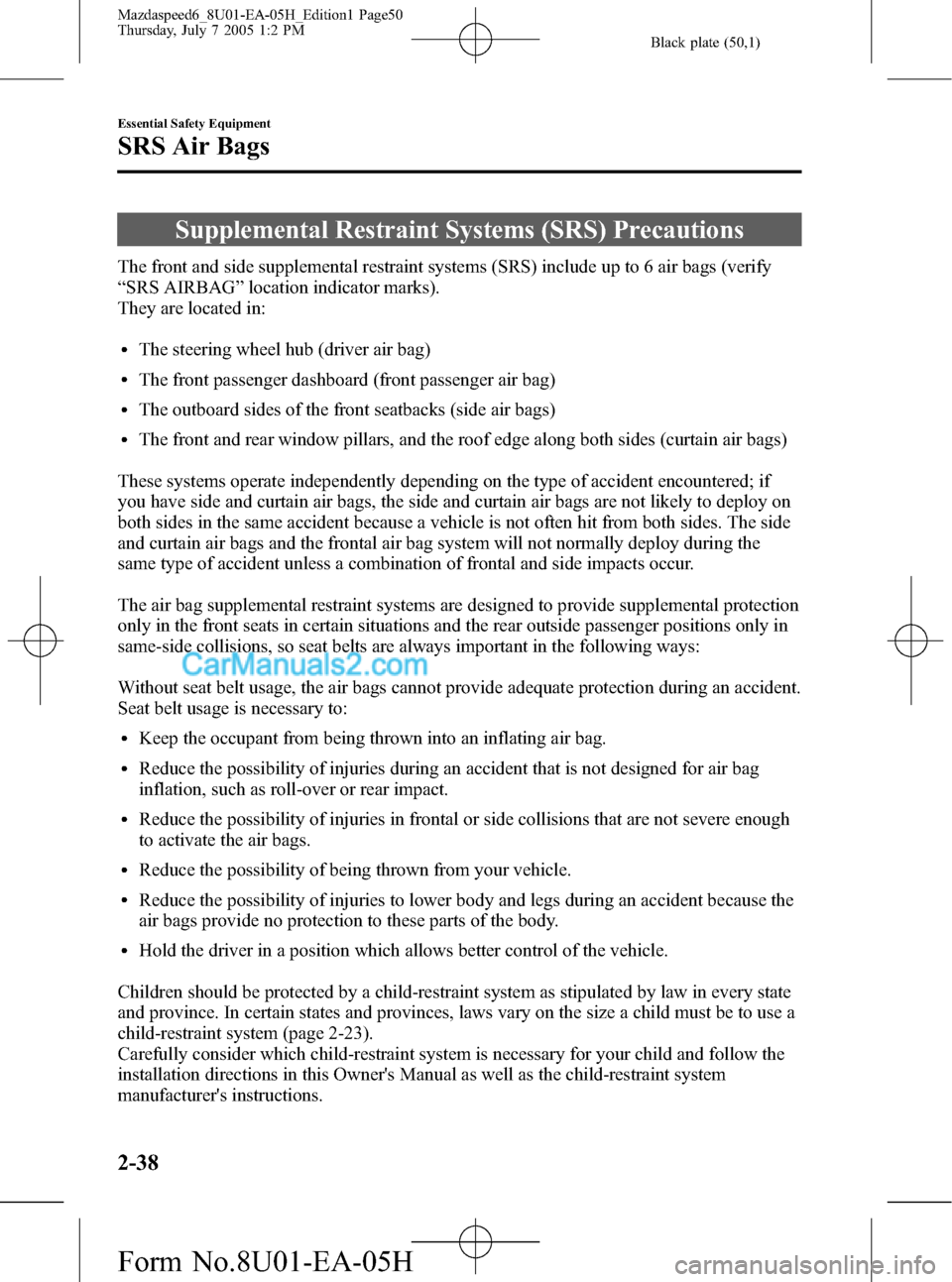
Black plate (50,1)
Supplemental Restraint Systems (SRS) Precautions
The front and side supplemental restraint systems (SRS) include up to 6 air bags (verify
“SRS AIRBAG”location indicator marks).
They are located in:
lThe steering wheel hub (driver air bag)
lThe front passenger dashboard (front passenger air bag)
lThe outboard sides of the front seatbacks (side air bags)
lThe front and rear window pillars, and the roof edge along both sides (curtain air bags)
These systems operate independently depending on the type of accident encountered; if
you have side and curtain air bags, the side and curtain air bags are not likely to deploy on
both sides in the same accident because a vehicle is not often hit from both sides. The side
and curtain air bags and the frontal air bag system will not normally deploy during the
same type of accident unless a combination of frontal and side impacts occur.
The air bag supplemental restraint systems are designed to provide supplemental protection
only in the front seats in certain situations and the rear outside passenger positions only in
same-side collisions, so seat belts are always important in the following ways:
Without seat belt usage, the air bags cannot provide adequate protection during an accident.
Seat belt usage is necessary to:
lKeep the occupant from being thrown into an inflating air bag.
lReduce the possibility of injuries during an accident that is not designed for air bag
inflation, such as roll-over or rear impact.
lReduce the possibility of injuries in frontal or side collisions that are not severe enough
to activate the air bags.
lReduce the possibility of being thrown from your vehicle.
lReduce the possibility of injuries to lower body and legs during an accident because the
air bags provide no protection to these parts of the body.
lHold the driver in a position which allows better control of the vehicle.
Children should be protected by a child-restraint system as stipulated by law in every state
and province. In certain states and provinces, laws vary on the size a child must be to use a
child-restraint system (page 2-23).
Carefully consider which child-restraint system is necessary for your child and follow the
installation directions in this Owner's Manual as well as the child-restraint system
manufacturer's instructions.
2-38
Essential Safety Equipment
SRS Air Bags
Mazdaspeed6_8U01-EA-05H_Edition1 Page50
Thursday, July 7 2005 1:2 PM
Form No.8U01-EA-05H
Page 51 of 354
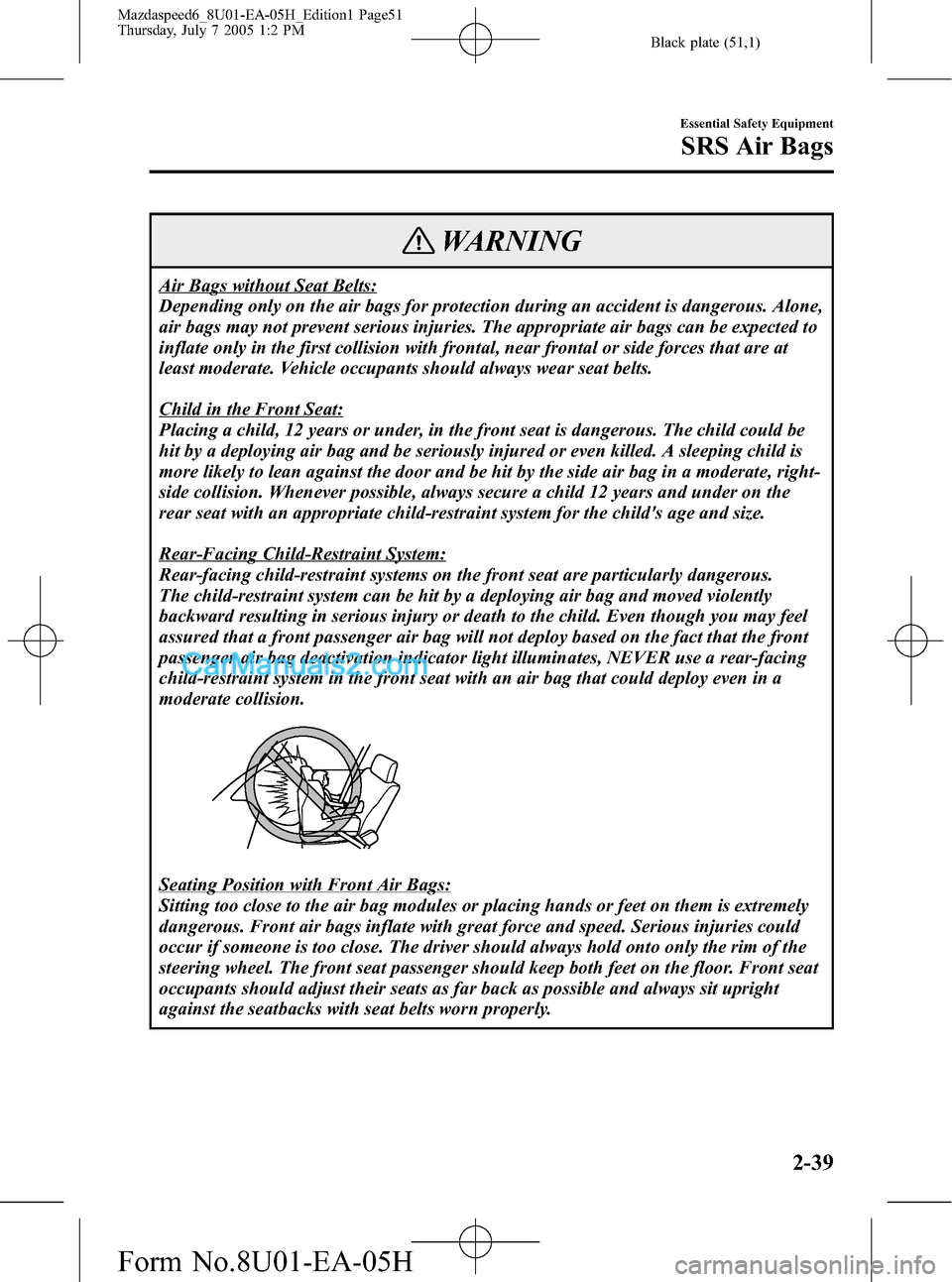
Black plate (51,1)
WARNING
Air Bags without Seat Belts:
Depending only on the air bags for protection during an accident is dangerous. Alone,
air bags may not prevent serious injuries. The appropriate air bags can be expected to
inflate only in the first collision with frontal, near frontal or side forces that are at
least moderate. Vehicle occupants should always wear seat belts.
Child in the Front Seat:
Placing a child, 12 years or under, in the front seat is dangerous. The child could be
hit by a deploying air bag and be seriously injured or even killed. A sleeping child is
more likely to lean against the door and be hit by the side air bag in a moderate, right-
side collision. Whenever possible, always secure a child 12 years and under on the
rear seat with an appropriate child-restraint system for the child's age and size.
Rear-Facing Child-Restraint System:
Rear-facing child-restraint systems on the front seat are particularly dangerous.
The child-restraint system can be hit by a deploying air bag and moved violently
backward resulting in serious injury or death to the child. Even though you may feel
assured that a front passenger air bag will not deploy based on the fact that the front
passenger air bag deactivation indicator light illuminates, NEVER use a rear-facing
child-restraint system in the front seat with an air bag that could deploy even in a
moderate collision.
Seating Position with Front Air Bags:
Sitting too close to the air bag modules or placing hands or feet on them is extremely
dangerous. Front air bags inflate with great force and speed. Serious injuries could
occur if someone is too close. The driver should always hold onto only the rim of the
steering wheel. The front seat passenger should keep both feet on the floor. Front seat
occupants should adjust their seats as far back as possible and always sit upright
against the seatbacks with seat belts worn properly.
Essential Safety Equipment
SRS Air Bags
2-39
Mazdaspeed6_8U01-EA-05H_Edition1 Page51
Thursday, July 7 2005 1:2 PM
Form No.8U01-EA-05H